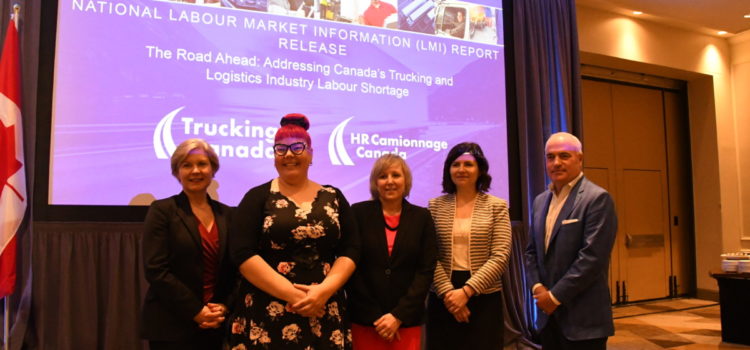

Trucking in Canada faces acute shortages
Business & TechCanadaUncategorized Mar 11, 2020 Mariana Belham

Canada is suffering an acute trucking labour shortage, according to the newest Trucking HR Canada (THRC) report released at a press conference at the Toronto Airport Marriott Hotel on March 11.

The report, titled The Road Ahead: Addressing Canada’s Trucking and Logistics Industry Labour Shortage, looks at the reasons behind the labour shortage, the economic and social consequences, and the expectations for the future of trucking. THRC says it includes the most extensive data available about the industry.
Why Does It Matter?

According to Angela Splinter, CEO of THRC, the drivers’ shortage can have multiple impacts on Canadians.
“The impact of Canada’s critical driver shortage is felt beyond the trucking industry. The trucking sector connects consumers, businesses and the international market, that are vital to our economic stability and performance,” said Splinter.
Splinter also pointed out the high importance of truck drivers during the COVID-19 response.
“It is us, truck drivers, who will be the chaperones for how many of the medical items, supplies and ultimately vaccines get to Canadians in large cities and small communities across the country,” said Splinter.
The Constrained Industry: The Acute Shortages Breakdown
The research partially was funded by the Government of Canada’s Sectoral Initiatives Program (SIP). It was a partnership between THRC and The Conference Board of Canada (CBoC). Kristelle Audet, the principal economist of the CBoC, presented the results of the survey.

The report shows that there are a very small number of truck drives available for the number of vacancies offered, leading to a historical unemployment rate. “The truck transportation industry is unable to fill roughly one out of every 15 positions – mostly truck drivers. In fact, the total number of truck driver vacancies in Canada more than doubled since 2016, from an annual average of 8,600 to 20,500 in the first three quarters of 2019,” says the report.

On top of that, the report points out that “while filling truck driver positions is difficult no matter what the driving job is [short-haul or long-haul], it is more difficult to recruit truck drivers who are willing to spend time away from home each week.”
The report says that the key factors that contribute to the labour shortage are the misconceptions among women and youth, an ageing workforce and a high voluntary turnover rate.
The report shows many consequences of this trend:
- A spike in wages, as employers need to pay more to current drivers to keep the work attractive.
- The current workforce gets older, leading to more retirements, which could lead to a bigger shortage.
- Smaller transportation companies can’t hire more drivers and can’t expand.
- Around 53% of employers said there was an increase in stress for existing drivers
Overall, there’s an estimated loss of $3.1B on sales that couldn’t be made because there aren’t enough drivers
Large Fleets: The Recruitment Teams are Maxed
Linda Young, board chair at THRC and vice-president of Human Resources at Bison Transport, was one of the speakers representing a larger company.

Linda Young, board chair at THRC and vice-president of Human Resources at Bison Transport, was commenting on the shortage from a larger company perspective. (Photo by Mariana Belham)
Young explained how the recruitment team has tried everything they can, but shortages are still concerning.
“Recruitment specialists are highly stretched, continuously searching for that next solution. This ongoing challenge takes its toll in the form of turnover of key recruitment staff, which disrupts the recruitment cycle and causes further delays in filling those vacancies,” Young said.
Young also mentioned the extensive list of approaches to engage new drivers, using online platforms such as Kijiji, LinkedIn, Indeed, Zip Recruiter, Facebook, Instagram, Twitter, to marketing automation e-blasts. “They approach this with a ‘shotgun’ approach, searching for those evasive solutions trying to figure out those jobs on a daily basis, when there’s unseated trucks on the fence that aren’t running but they are still responsible for,” said Young.
“They’ve invested in newspaper and digital advertisement, billboards, truck stop posters, vlogs… Shall I go on? The list is longer,” said Young.
“Sponsorships including television, increase profile at truck shows, signage on trailers, career fairs focusing on driver skills, indigenous communities, community centres anything that will do that will be an attempt to say they’ve tried.

Young then added, “sign-up bonuses, referral campaigns, open houses, […] finishing programs for new drivers all in the attempt to either buy or build that driver and yet we sat today with 30 unseated tractors and excess of 40 unfilled non-driving jobs. […] As a viable industry struggles to grow, it leads us to the question, who knows how many Canadian jobs could have been created?”
Another issue that arises from the shortage is that part of the potential workforce works for alternative companies, “resulting in some non-compliance in the form of labour and tax, that not only hurts our industry but it hurts us all as tax-paying Canadians.”
Finally, Young pointed out other factors that make it difficult for companies to expand.
“We’re also distracted in some ways, working with increasingly the strictest employment legislation for scheduling rules and paid absences, complex integration requirements and cost that are counter to the productivity of this recruitment cycling.”
Young hopes to use the data available at the report to understand what are the specific areas that need to be fixed and how the shortages could be solved, to do “evidence-based decision making.” “The labour shortage is real and has to be recognized and acted upon.”
Small Fleets: The Most Impacted
David Carruth, President and CEO of One For Fright, was the third speaker to present at the press conference. He offered the perspective of a smaller employer, which is greatly impacted.

“For a small fleet employer, it’s particularly hard as one driver vacancy equals a significantly larger proportion of our business than in a larger company,” said Carruth.
“Our managers, our supervisors have had to step in and do frontline roles. As a result, operations gets less attention, and we have to move an increased focus on our recruitment strategies,” said Carruth.
He then said that the immediate consequences are magnified delays and inefficiencies, causing over-time, “which directly counters our commitment to a work-life balance to our professional drivers and to the rest of our team members. All of this impacts the bottom line and our ability to service our clients.’
Carruth then talks about a topic introduced by Young, the non-compliant companies. They operate at the “Driver Inc Model”.
This model constitutes “self-incorporated drivers that operate company vehicles and […] are not deducted any source deductions from their pay, according to truck lease company PowerLease. ”
“The driver inc model is one that particularly impacts our ability to recruit and train drivers,” said Carruth. “We have seen a significant number of decreasing calls from potential drivers wanting to be paid under the driver inc model. Before, we could get three out of four calls a week from professional drivers looking to be compensated this way. We saw many people lose interest in our company, where we compensate via payroll and, thus, paying income tax and other deductions.”
Carruth also detailed more consequences of the Driver Inc Model, which affects mostly “new Canadians are being taken advantage of as many do not understand the employment regulations that exist in our own place to protect them in Canada.”
“Carriers are enticing professional drivers with the prospect of being an entrepreneur, but when they hire them, they don’t give them the tools on how to actually run their business. In reality, the entrepreneur is signing all of their rights away, that are available to him,” said Carruth. “This picture contributes to misconception in our industry of profits over people.”
What the Future Holds
When Carruth finished his speech, he applauded new initiatives that include more women in the trucking industry, such as the feminine makeup of the conference. One example he gave is the “Woman with Drive”, which is holding a summit on March 12.
Myrna Chartrand is the face of the new horizons for trucking. She the winner of Manitoba Trucking Association’s 2018 Driver of the Year. The long-haul driver’s reputation has been growing in the Canadian trucking workforce due to her unique style, and Pinky, her pink truck.


Chartrand’s story was brought to the conference to inspire other people. After years of working in the pharmaceutical industry, Chartrand felt compelled to change the direction of her life. She started training and became a truck driver.
She likes to spread her story to show woman and young people that is a viable profession, to expose herself to show “to break the stereotype of what a truck driver looks like.”
“I can represent breast cancer awareness, get to go to so many different convoys truck shows, I’ve been in calendar shoots for women in trucking,” Chartrand said. “I just, whatever I can get out there, to get an invite to, I’m going to be there because I want to promote myself, I wanted to promote women in trucking, young people in trucking.”
Chartrand said she often gets many questions about trucking. “There’s just so much more to it that I don’t think people realize. Here [the press conference] is a perfect opportunity to represent of what else there is, it’s not sitting behind the wheel driving, there’s so much else you can experience.” She then adds, “I have no problem with being a mentor, I want to help whenever I can.”

Chartrand also gave a bit of advice for those potentially into trucking, “When I first started tripping I was never afraid to ask a question. Trucking companies offer mentorship programs.”
She is glad that she had the support from her friends and family, “when I wanted to give up no one was going to let me fail, they were there to push.”
She finished her speech encouraging people to take a look into trucking. “You’re going to see some interesting people, you’re going to see some of the most interesting sites,” Chartrand said.
Chartrand joked that “if you work a Monday to Friday job, you don’t see people shaving their back in a Truck Stop Parking Lot in the middle of the day; you don’t see anybody selling cotton candy under the bridge in Chicago, you know, I see these things!”
“That’s I went into trucking, you know, look at the people! It opened my eyes, […] like ‘wow, look at how other people live’,” Chartrand continued.
Another aspect of trucking that Chartrand pointed out is freedom. “I know what the E-laws and regulations we’re still governed, but you don’t have somebody watching over your shoulder if your bathroom break takes eight minutes instead of five.” She then added, “you have to get from point A to point B, between this day and that day, so do with it what you will.”


Chartrand was happy to share that trucking helped her to express her individuality, “You have the ability to express yourself and your individuality. […] I’m so happy to basically represent through my company represent myself,” she said.
Chartraded concluded with an optimistic point of view, “All I want to say is that the sky’s the limit on trucking, don’t narrow your view and this life is what you make of it, is look at the big picture and you can go for it.
For more information and data, check Trucking HR Canada.
